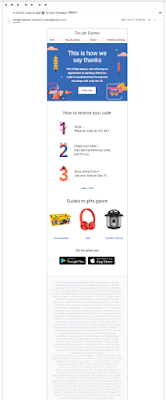This minor Fail for Creative and Timing is a lesson for all online marketers.
Google
Express had a targeted
promotion where customers who make an eligible purchase through their shopping
portal between November 5 and November 25 would receive a “surprise” thank-you
discount with a personalized promo code on November 27. Deep in the
disclosure, the copy explains (in presumably intentionally hard-to-read, faded gray-over-gray type—a
Fail for Creative) that, while most customers would receive a $10 discount, 100
customers would enjoy a $100 discount—and five lucky customers would get a $500
discount. I guess that is what makes it a surprise.
 |
| Google Express promotion solicitation email with a long, hard-to-read disclosure |
I made a qualifying purchase
and, while I did not receive the discount code on November 27, I did receive it
on December 1. It was four days late and for only $10, but that
still beats a poke in the eye.
 |
| Fulfillment email from Google Express |
Two days later, I went
to make a purchase using the promo code by clicking on the email button labeled
“Shop Now,” with a sleeping fox on it. I was greeted with this landing
page:
 |
| Shop Now landing page |
The headline reads “Our
thank-you offer has ended.” However, I had received my thank-you
email—not with an “offer” but with the promised discount code. It appears
to me that this web page was written to be displayed starting November 26, the
day after the purchase eligibility period ended.
If this was the
appropriate landing page for the “Shop Now” button sent on December 1, it
should reinforce the holiday discount. Or perhaps “Shop Now” was supposed
to go to a different landing page. Either way, the lessons are the same.
Lessons:
- If you want your customers to understand your offer, don't disguise your disclosure content with poor color contrast. If you don't want your customers to understand your offer, ask yourself why.
- Be timely in your fulfillment of an offer. It’s better to underpromise and overdeliver than overpromise and underdeliver.
- Ensure that all links in your customer emails are mapped to the correct landing page, and that your corresponding landing page is current and appropriate for your marketing campaign.
Update 12/5
Google Express changed the 'Shop Now' link landing page to something even more confusing:
 |
| Shop Now landing page 12/5/18 |
















